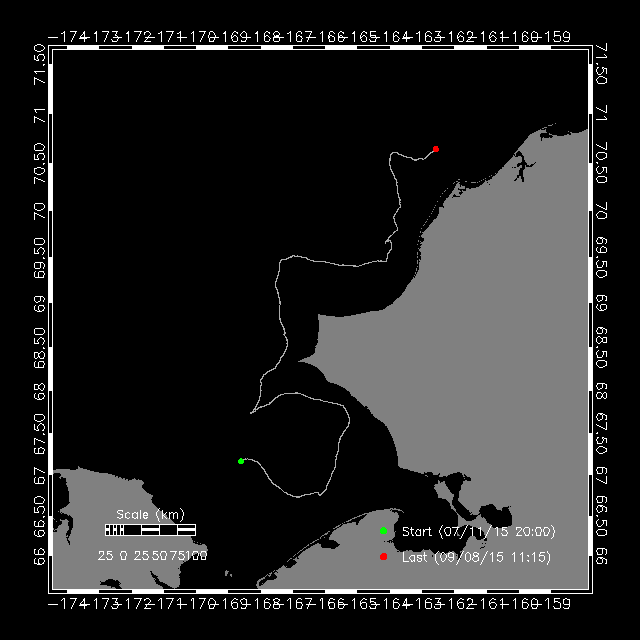Autonomous Real-time Marine Mammal Detections
Woods Hole Oceanographic Institution
Chukchi Sea, Arctic, Summer 2015
Study objectives
A Slocum G2 glider was deployed in the Chukchi Sea off the northwest coast of Alaska on July 11, 2015 to study the occurrence of several species of marine mammals, including fin, bowhead, and beluga whales, as well as bearded seals and walrus. This project is designed to examine relationships between marine mammal distribution and oceanographic conditions monitored by the glider. Results shown on this page have been reviewed by an experienced analyst (Kate Stafford) and represent locations and times where the near real-time passive acoustic detection data provide evidence of species occurrence.
Principal Investigators: Peter Winsor (University of Alaska Fairbanks), Kate Stafford (University of Washington), and Mark Baumgartner (WHOI).
Platform unit_191
Platform location:

Daily analyst review:
| | Detected |
| Possibly detected |
| Not detected |
Analyst-reviewed species occurrence maps:

Analyst-reviewed time series:

Analyst-reviewed diel plot:

Oceanographic observations:

Links to detailed information for platform unit_191:
Automated detection data
DMON/LFDCS diagnostics
Platform diagnostics
Questions
Please email Mark Baumgartner at mbaumgartner@whoi.edu. For a general desciption of the detection system and the autonomous platforms, visit dcs.whoi.edu.
Acknowledgements
The Slocum glider was expertly prepared by Hank Statscewich (UAF) with assistance from Brita Irving (UAF). Deployment was made possible by Anthony Fischbach (USGS Alaska Science Center Walrus Research Program), chief scientist of the deployment cruise on the R/V Norseman II. At sea assistance was provided by the captain and crew of the R/V Norseman II. Critical engineering support was provided by Keenan Ball, Jim Partan, and Tom Hurst (WHOI). Support for the development of the Arctic marine mammal call library, preparation of the DMON/LFDCS, and preparation and operation of the glider for this study was provided by the Alaska Ocean Observing System. The DMON instrument was developed by Mark Johnson and Tom Hurst at WHOI. Mark Johnson was responsible for developing the application programming interface (API) for the DMON, and coded an early DMON implementation of the pitch tracking algorithm described in Baumgartner and Mussoline (2011). Support for the development and testing of the DMON/LFDCS was provided by the Office of Naval Research, and additional support for integration and testing was provided by the NOAA National Marine Fisheries Service Advanced Sampling Technologies Working Group in collaboration with the Northeast Fisheries Science Center's Passive Acoustics Research Group (leader: Sofie Van Parijs).
Home




